
Domaine Lucien Muzard & Fils
Presentation of the Lucien Muzard & Fils estate
DISCOVER THE WINES OF DOMAINE LUCIEN MUZARD & FILS
-
Domaine Lucien Muzard & Fils: The essentials
- The origins of the family estate date back to the early 1645s.
- Domaine Lucien Muzard & Fils was founded in 1960
- The estate is located in the village of Santenay
- 20.5 hectares of vines in 21 appellations.80% red, 20% white
- 2 white regional appellations
- 5 white village appellations
- 2 white 1er crus appellations
- 1 regional red appellation
- 5 village appellations in red
- 6 red 1er crus appellations
- HVE (High Environmental Value) certified since 2021. Uses only ORGANIC products
- Planting trees and hedges in the vineyards to optimise the vine's ecosystem.
- Whole harvest adapted to each cuvée according to the age of the vines and the vintage.
- Aged in 228-litre oak tuns and barrels for the reds and 350-litre oak barrels for the whites for 12 months, then in vats for 4 to 6 months. Approximately 10-15% of the barrels are new. Addition of 600-litre barrels from 2022.
-
History of the Lucien Muzard & Fils estate
The history of the Lucien Muzard & Fils estate can be traced back to a prestigious line of winegrowers whose roots reach deep into the past, as far back as 1645. It was in 1960 that Lucien Muzard, accompanied by his wife Paule, decided to found the eponymous estate. Acquiring virgin land, Lucien planted vines, laying the foundations for a wine heritage of inestimable value for future generations.
In 1987, his eldest son Claude joined the family venture, followed by his youngest son Hervé in 1990, both of whom had previously studied at the prestigious Lycée Viticole in Beaune. Their arrival marked a turning point for the estate, which gradually gave up selling its grapes in bulk to concentrate entirely on bottle production. Today, the entire production is bottled on site.
Under the management of Claude and Hervé, the estate has innovated, deciding in particular to age their wines in new tuns from the Rousseau cooperage and to include a large proportion of whole grapes in their cuvées. This bold approach led to the creation of the cuvée Hommage, a Santenay 1er Cru Beauregard in which the entire harvest is vinified as whole grapes, paying tribute to their father.
In 2019, a new generation will be joining the estate with the arrival of Capucine, Claude's daughter. Her aim: to modernise communications while deepening her knowledge of viticulture and winemaking. From 2023, she will become a full partner in the estate, alongside her father and uncle, carrying on the family tradition and heritage.
This centuries-old history, marked by passion, innovation and respect for tradition, continues today with the same determination and love for wine, making the Lucien Muzard estate a benchmark in the world of wine.
-
The philosophy of the Lucien Muzard & Fils estate
The philosophy of Domaine Lucien Muzard & Fils is based on several fundamental pillars, guided by a deep respect for the terroir and traditions, while incorporating modern winemaking methods.
Claude, Hervé and Capucine believe in an approach close to nature, where every action is thought out in harmony with the ecosystem and biodiversity of the vines. For example, the estate plants trees and hedges around the vineyard plots to encourage animal and plant life.
"The music of wine is worked on every day and perfected with experience and practice" Claude
Particular attention is paid to work in the vineyards, where the teams put all their know-how and passion into producing exceptional grapes. They practise environmentally-friendly agriculture, with an organic approach, although not certified as a matter of principle. Their aim is not to follow specifications blindly, but rather to listen to the needs of each plot and follow the natural development of the vines.
The wines produced by the estate are above all pleasurable wines, designed to be shared around a good table in a convivial atmosphere. Accessible from their first year, they offer an explosion of flavours to delight the taste buds. But some of their vintages will be better suited to laying down, gaining in complexity and elegance over the years.
"For me, wine and good food will always be the best communication tool! Claude
Finally, the estate attaches great importance to the working atmosphere. Some of their employees have worked at the estate for more than 30 years, demonstrating their commitment to creating an environment in which everyone can develop both professionally and personally.
At Domaine Lucien Muzard, they cultivate much more than grapes, they cultivate a passion for wine and a deep respect for the land that nourishes us, with the aim of creating exceptional wines that embody all the authenticity of the Burgundy terroir.
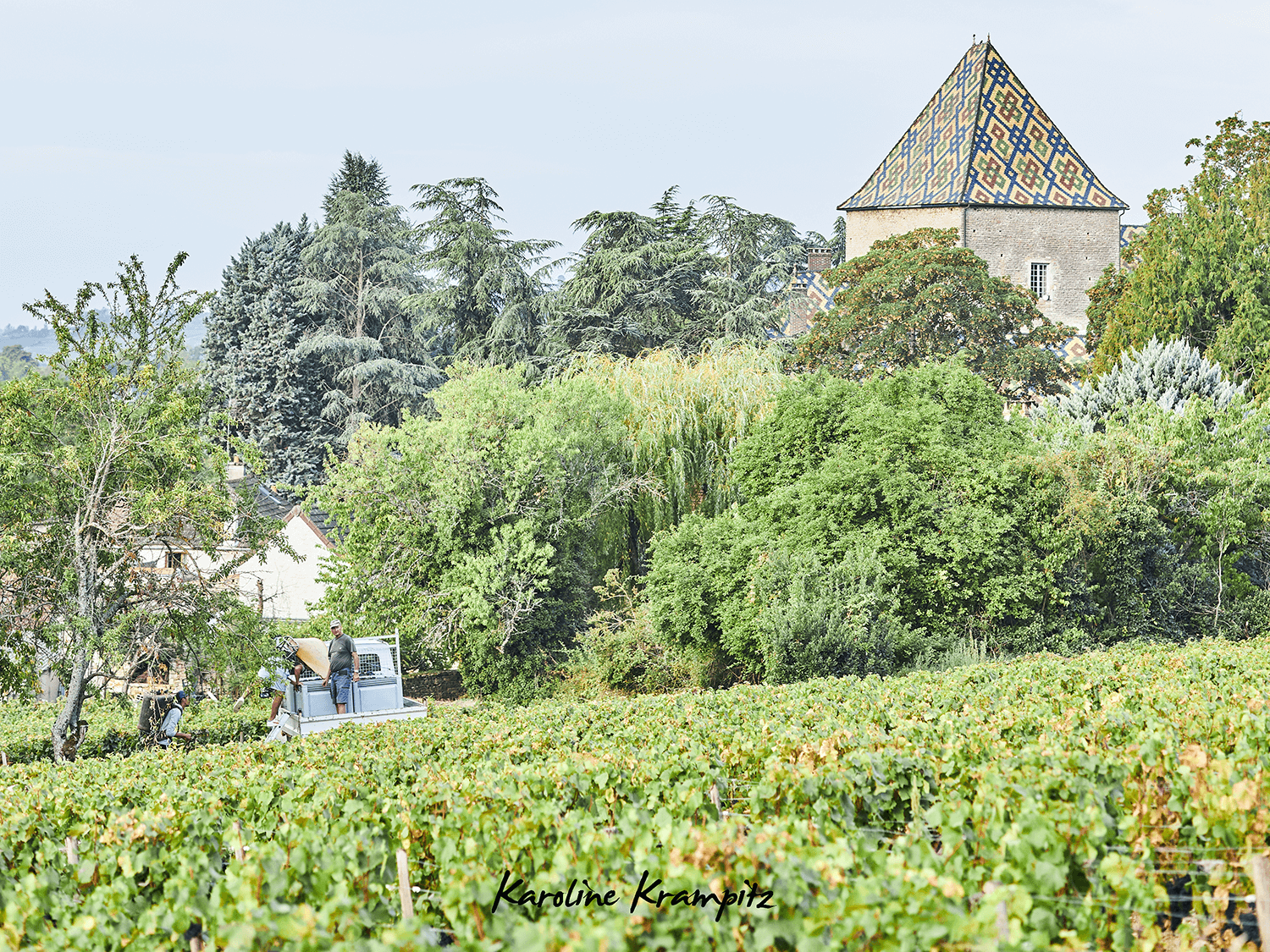
-
Managing the vines of Domaine Lucien Muzard & Fils
Soil management
At Domaine Lucien Muzard & Fils, vineyard soil management is an absolute priority. The estate is deeply committed to environmentally-friendly practices aimed at preserving the health of the soil and promoting the optimal development of the vines.
At Muzard, we are aware of the risks associated with soil compaction and erosion, which is why measures are put in place to remedy the situation. The estate limits the use of tractors in the vineyards as much as possible, particularly during periods when the soil is wet. This precaution preserves the structure of the soil and prevents excessive compaction.
In addition, light scratching of the soil and shallower ploughing are preferred, to promote better aeration and water infiltration. These practices help to maintain soil fertility and prevent erosion.
After the harvest, the vines are deliberately left to grass. This practice has many advantages, including preserving biodiversity, reducing erosion and improving soil structure. Plant cover is used between the rows of vines to protect the soil and encourage regeneration. Ground cover plants are selected according to the specific needs of the vine and the nature of the soil. Different varieties such as clover, mustard, rye and faba bean are being tested, each providing specific benefits to the wine-growing ecosystem.
In spring, the grass is mown and the plant waste is used as fertiliser, enriching the soil with organic matter and nitrogen, essential elements for healthy vine growth.
By adopting these practices that respect the environment and biodiversity, the Muzard family is committed to preserving the health of its soils and producing exceptional wines that fully reflect the authenticity of its terroir.
Pruning the vines
Pruning is a crucial stage in the creation of exceptional wines. At Muzard, each grape variety is treated with the utmost care. Chardonnay vines are pruned using the Guyot simple method, while Pinot Noir vines are cordon pruned. This tailor-made approach ensures the optimum development of each grape variety, preserving the quality and balance of the harvest.
Pruning begins in December with a pre-pruning, followed by a final pruning in February. The choice of these periods is crucial: the estate avoids pruning when the vines are active, thus preserving their vitality and health.
At the estate, nothing is lost, everything is transformed. Prunings are shredded on site and scattered around the plots as plant cover. This environmentally-friendly practice enriches the soil with organic matter, promoting biodiversity and soil fertility.
Faced with drought and intense heat, the Lucien Muzard estate has adapted its pruning practices to protect the vines. By increasing the height and width of the pruning, more leaves are left to shelter the bunches from the scorching sun. This strategy also improves photosynthesis in the plants, promoting their growth and resilience in the face of extreme weather conditions.
In addition, trees have been planted and soil compaction is limited to encourage the infiltration of water into the soil and reduce evaporation. Leaf thinning, carried out on the side facing the rising sun, is also carried out early in the year to allow the vines to put on new leaves before the summer.
To guarantee controlled yields and quality harvests, disbudding is carried out with precision. This technique limits the number of bunches per vine, ensuring even ripening and a concentration of aromas in the grapes.
Thanks to expert management of vine pruning, the Lucien Muzard estate continues its commitment to the quality and authenticity of its wines, offering its customers vintages of rare excellence, the fruit of a subtle marriage between tradition and innovation.
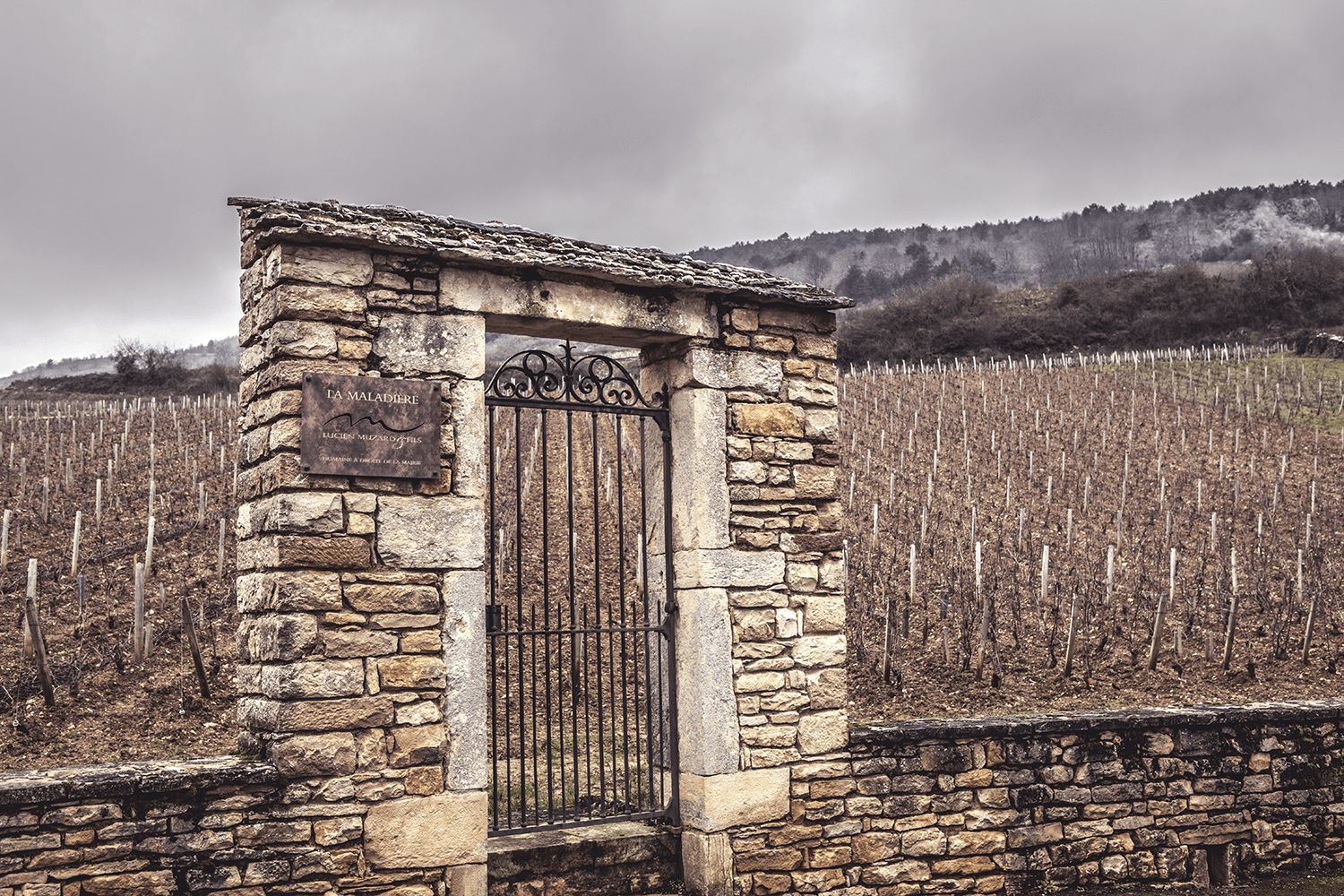
Treatment
At Lucien Muzard, the management of vine treatments is an approach marked by respect for the environment and biodiversity. The estate is committed to limiting the use of chemical products while preserving the health of the vines and the quality of the harvest through a balanced approach to preserving flora and fauna.
The main objective at the Lucien Muzard estate is to minimise the use of treatments, in order to respect the delicate balance of the ecosystem that develops within the vines. By reducing the number of tractor passes, the estate also limits soil compaction, thus preserving its structure and natural fertility. On average, between 7 and 10 passes are made each year, adjusted according to weather conditions and disease pressure.
The Muzard family is firmly committed to an environmentally-friendly approach, using only organic treatments to protect the vines. This approach guarantees the preservation of biodiversity and the health of the soil, while ensuring the quality and authenticity of the wines produced.
Through its ecological management of treatments, the Lucien Muzard estate is part of a sustainable and responsible approach, contributing to the preservation of the environment and the promotion of winegrowing that respects nature. This approach guarantees the longevity of the vines and the quality of the harvests, offering wine-lovers exceptional products from an ethical and committed approach.
-
Method of vinification
Discover the secrets of meticulous vinification at the Lucien Muzard estate, where each stage is carefully orchestrated to reveal the full splendour of the wines.
For white wines
At Domaine Muzard, the grapes are harvested exclusively by hand. This traditional approach guarantees respect for the fragile grapes, preserving their integrity and intrinsic quality. The grapes are gently transported in hoods to medium-sized bins, avoiding any crushing or excessive settling.
As soon as they arrive at the winery, the grapes are chilled in temperature-controlled vats for between 12 and 24 hours. This stage preserves the freshness and complexity of the grapes' aromas, ensuring that the final wines express the terroir to the full.
Once pressed, the musts are lightly settled before alcoholic fermentation begins in vats. Fermentation then continues in barrels, using indigenous yeasts to infuse the wines with all the authenticity of the terroir.
Since the 2022 vintage, no sulphur has been added during vinification, until the end of malolactic fermentation. This reflects the estate's commitment to more natural, environmentally-friendly winemaking practices.
Since 2022, the white wines have been aged for 12 months in 600-litre barrels. This larger barrel size is designed to preserve the balance of the wines, avoiding excessive oakiness that would mask the finesse of the aromas. On average, 10-15% new barrels are used, adding a subtle touch of complexity without overpowering the character of the wine.

For red wines
At Lucien Muzard, harvesting the red grapes is a crucial moment, carried out exclusively by hand. The bunches are sorted directly in the vines before being delicately picked and transported in hoods to medium-sized bins, thus preserving their integrity and quality.
On arrival at the winery, the grapes are chilled in temperature-controlled vats for 12 to 24 hours. This stage preserves all the freshness and complexity of the grapes' aromas, ensuring the best possible expression of the terroir in the finished wines.
The grapes are never crushed. They are partially destemmed, with around 30% whole grapes, depending on the cuvée and the characteristics of the vintage. Alcoholic fermentation takes place using indigenous yeasts, thus preserving the wine's authenticity. A light punching down of the cap is carried out during vatting, followed by regular pumping over to avoid excessive extraction and preserve the freshness of the fruit. Unlike the estate's white wines, a small amount of sulphur is added during vinification.
After a vatting period of 15 to 20 days, the wines are devatted and blended with the free-run wine and the press wine. The red wines are matured for 12 months in 228-litre casks and tuns, to avoid excessive oakiness and better reflect the terroir. On average, 10-15% new barrels are used, adding a subtle touch of complexity without masking the purity of the fruit.
By choosing Domaine Lucien Muzard wines, you are opting for excellence, authenticity and respect for the terroir. Each bottle is the fruit of meticulous work, combining tradition and expertise to deliver an unforgettable taste experience.
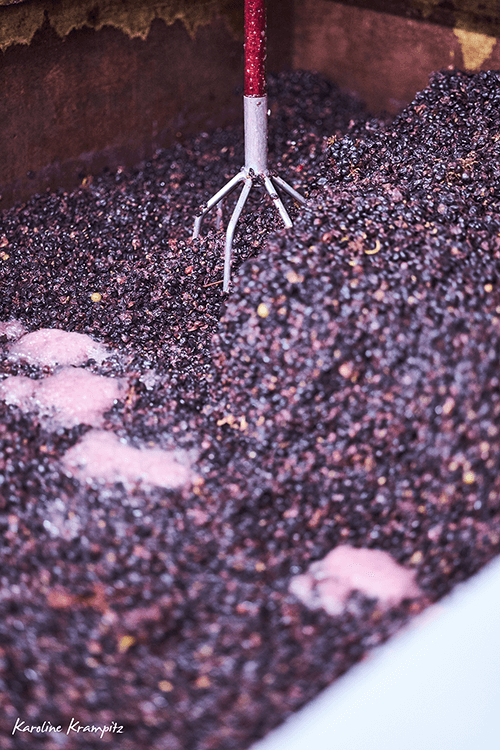
DISCOVER THE WINES OF DOMAINE LUCIEN MUZARD & FILS
-
The vines of Domaine Lucien Muzard & Fils
White wines
Bourgogne Aligoté
PLOT: The grapes come from two old vines, one in the commune of Remigny, the other in Meursault. The soils are clay-loam.
SOIL: Clay-loam
VINEYARDS: The soil is ploughed, the vines are de-budded, lifted, thinned out, aerated and harvested by hand.
AGEING : Malolactic fermentation takes place completely over winter in the estate's underground cellars in 350-litre barrels for 9 months.
TASTING: Peak: 3 years
Burgundy Chardonnay
IN THE VINEYARDS: The grapes are bought from an estate working with the same philosophy. They also work the soil, disbud, thin out the leaves and harvest by hand.
AGEING : Malolactic fermentation takes place completely over winter in the estate's underground cellars in 350-litre barrels for 9 months.
TASTING: Peak: 3 years
Santenay Champs Claude
PLOT: The vineyard is located 20 metres from the bottom of Les Morgeot, 1er cru de Chassagne, on a gentle slope with an easterly exposure. It has a surface area of around 1ha50.
VINEYARDS: The plot was planted in 1990 and again in 2005. It covers 1.57 hectares and is pruned using the Guyot simple method. The soil is worked with various ploughs. The vines are de-budded and the leaves are thinned out on the rising sun side, by hand, to accustom the bunches to the sun and aerate the vegetation. The grapes are harvested by hand.
AGEING : Malolactic fermentation takes place completely over winter in the estate's underground cellars. The wine is aged for 12 months in 350-litre barrels, with a third of the cuvée aged in tuns before being blended for around 2 months.
TASTING: This wine, made with a slight reduction, stands out for its intensity, purity and clarity, offering a crystalline sensory experience. On the palate, it has great presence, accompanied by pleasant notes of yellow grapefruit that linger right through to the finish. A magnificent wine that elegantly reveals the unique character of the Santenay terroir. A remarkable success.
Best drunk within 3 to 5 years.
Santenay 1er Cru "Maladière
PLOT: Maladière is a stony, steep, south-east-facing hillside planted on fissured limestone covered with a thin layer of marl.
VINEYARDS: The plot was planted in 2013 and is 57 ares in size. The soil is ploughed, the vines are de-budded, lifted, thinned out, aerated and harvested by hand.
AGEING : Malolactic fermentation takes place completely over winter in the estate's underground cellars in 350-litre barrels for 12 months.
TASTING: There is a slight reduction on the nose, while on the palate its energy evokes a real breath of freshness, with bright fruit perfectly balanced by a texture that is both dense and fleshy. This wine offers fruit of exceptional quality, enhanced by ageing that pays homage to it.
Apogée 5 years.
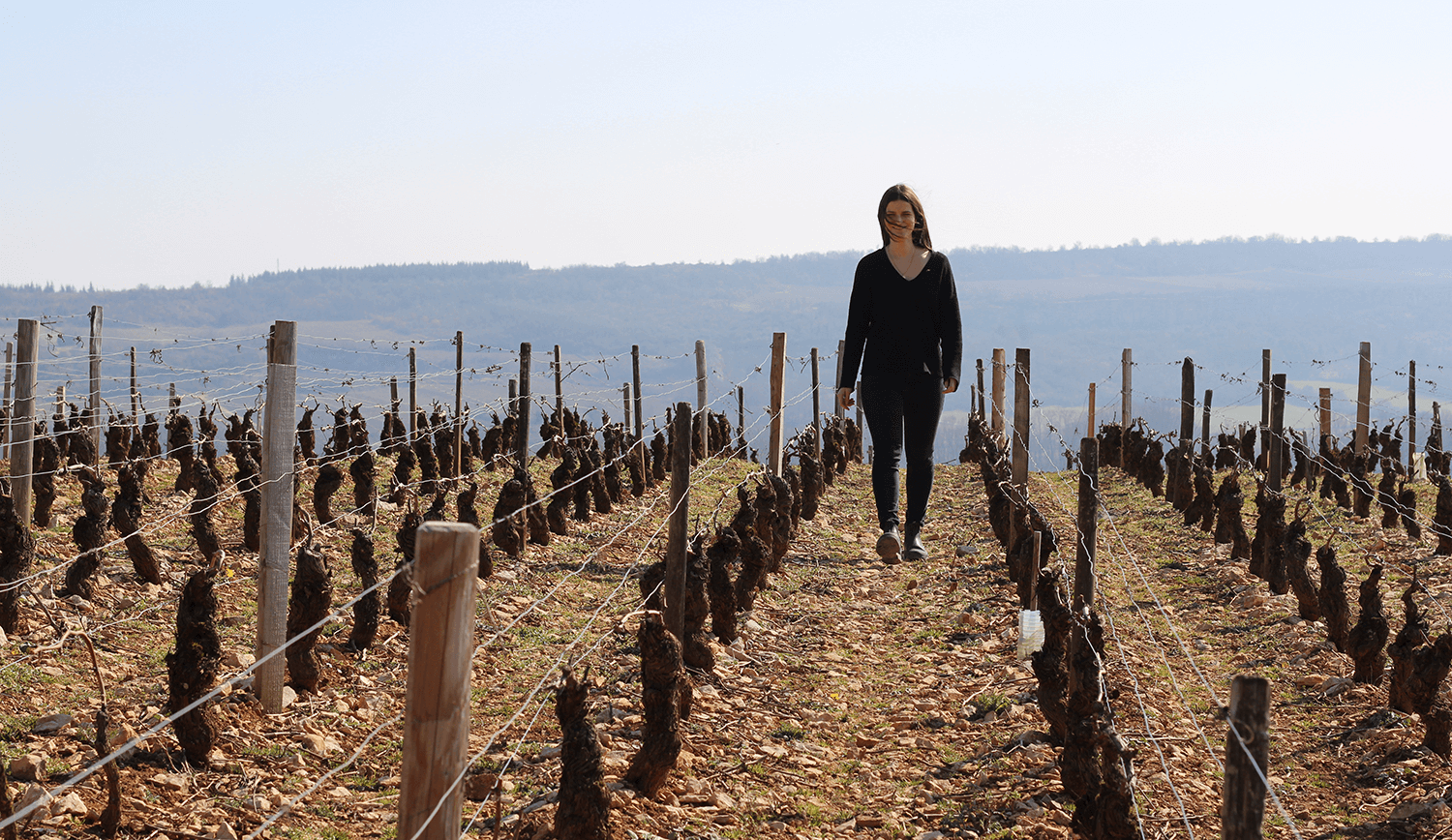
Santenay 1er Cru "Clos Faubard
PLOT: Situated at the top of a hillside, on a terrace, Clos Faubard enjoys sunshine all day long. A thin red soil covers the limestone bedrock. The estate cultivates 7 ares 14 on this terrace, and the vines, planted at 10,000 vines per hectare, are pruned in single guyot. They were planted in 2000.
VINEYARDS: Guyot simple pruning. The soil is worked with various ploughs. The vines are disbudded, and the leaves are thinned out on the sunrise side, by hand, to accustom the bunches to the sun and aerate the vegetation. Harvesting is done by hand.
AGEING : Malolactic fermentation takes place completely over winter in the estate's underground cellars. No new barrels are used, but one 350-litre barrel for 1 or 2 wines, depending on the vintage. Aged for 12 months.
TASTING: Apogée 5 years.
Chassagne-Montrachet
PARCEL: The vines are planted on a terroir of marl and limestone that retains a great deal of freshness and minerality deep down.
VINEYARDS: The plot is 10 ares in size, the vines are over 20 years old, the soil is ploughed, the vines are disbudded, lifted, thinned out, aerated and harvested by hand.
AGEING : Malolactic fermentation takes place completely over winter in the estate's underground cellars in 350-liter barrels for 12 months.
TASTING: Peak 5 years.
Meursault "Les Crotots Vieilles Vignes
PARCEL: This parcel is located at the bottom of the hillside on clay-limestone soil.
VINEYARDS: The soil is ploughed, the vines are de-budded, lifted, thinned out, aerated and harvested by hand.
AGEING : Malolactic fermentation takes place completely over winter in the estate's underground cellars in 350-liter barrels for 12 months.
TASTING: Here, we observe a significant increase in aromatic amplitude. On the palate, however, the fruit still seems enclosed in its shell. The material is dense, even robust, but in the background, a beautiful saline note develops. Cellar for a few years before drinking.
Apogée 5 years.
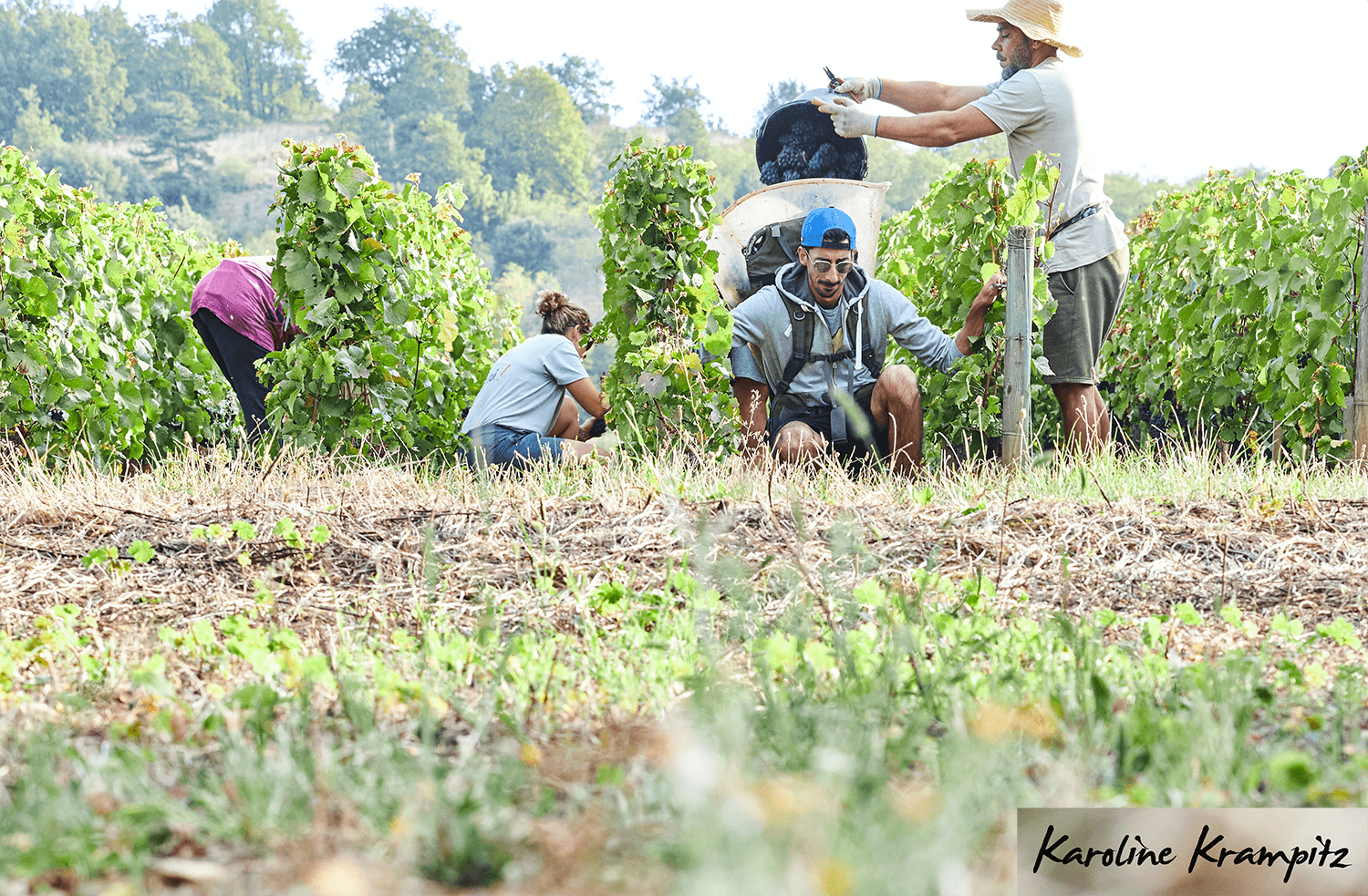
Meursault "Les Meix Chavaux
PARCEL: This parcel is located mid-slope on predominantly limestone-clay soil. It faces south-west. The plot was planted in 1988, 2001 and 1935 for the oldest part, and covers 0.75 hectares.
VINEYARDS: Guyot simple pruning. The soil is worked with various ploughs. The vines are disbudded, and the leaves are thinned out on the sunrise side, by hand, to accustom the bunches to the sun and aerate the vegetation. Harvesting is done by hand.
AGEING : Malolactic fermentation takes place completely over winter in the estate's underground cellars, in 350-liter barrels, for 12 months.
TASTING: The nose reveals delicate floral and almond notes. On the palate, its dense fruit offers delicate, stimulating bitterness, reminiscent of grapefruit. This magnificent wine brilliantly combines character and finesse.
Apogée 5 years.
Red wines
Bourgogne pinot noir
PLOT: Half of the vineyard is located in the commune of Santenay, at the foot of the Maranges hillside, and the other half near Chassagne-Montrachet, on clay-marl-limestone soil.
IN THE VINEYARDS: The soil is ploughed, the vines are disbudded, lifted, thinned out, aerated and harvested by hand.
VINIFICATION: The grapes are never crushed, and are largely destemmed (around 30% whole grapes). Alcoholic fermentation is carried out with indigenous yeasts. The wine is lightly pigmented during vatting.
AGEING: After 15 to 20 days, the wines are devatted and blended with free-run and press wine for aging in Burgundian oak barrels, 15 to 20% of which are new. Part of the cuvée is also aged in vats. Aged 9 months.
TASTING: Apogée 3 years.
Maranges:
PARCEL: Situated at the bottom of a hillside, in a cold area, on deep red clay soils. The parcel straddles the border between the Saône et Loire and Côte d'Or departments.
THE VINEYARD: Planted in 1963, the plot covers 54 ares. The vines are cordon de royat pruned, disbudded, aerated and hand-thinned.
VINIFICATION: The grapes are never crushed, and are largely destemmed (around 30% whole harvest). Alcoholic fermentation is carried out with indigenous yeasts. The wine is lightly pigmented during vatting.
AGEING: After 15 to 20 days, the wines are devatted and blended with free-run and press wine for aging in Burgundian oak barrels, 15 to 20% of which are new. Part of the cuvée is also aged in vats. Aged 12 months.
TASTING: The nose reveals black fruit aromas combined with a hint of smoke. On the palate, this wine is full-bodied and sapid, with supple tannins providing almost instant pleasure.
Apogee 5 years.
Santenay Vieilles Vignes
PARCEL: This terroir lies at an altitude of 270 m. Three parcels are combined to make this cuvée. The vines are located towards Chassagne, in the center of the village and towards Les Maranges. They are all gently sloping, facing east, on clay-marl soil where limestone outcrops in places.
VINEYARDS: Domaine Lucien Muzard farms 3 hectares. The average age of the vines is over 60 years, pruned in cordon de royat. The soil is ploughed, and the vines are disbudded, lifted, thinned out, aerated and harvested by hand.
VINIFICATION: The grapes are never crushed, and are largely destemmed (around 30% whole harvest). Alcoholic fermentation is carried out with indigenous yeasts. The wine is lightly pigmented during vatting.
AGEING: After 15 to 20 days, the wines are devatted and blended with free-run and press wine for aging in Burgundian oak barrels, 15 to 20% of which are new. Part of the cuvée is also aged in vats. Aged for 12 months.
TASTING: We highly recommend this cuvée, which combines deliciousness, expressiveness and depth. Although it's not particularly dense, it more than makes up for it with a pleasantly fine texture.
Apogée 5 years.
Santenay Champs Claude Vieilles Vignes
PARCEL: This terroir lies at an altitude of 270 m. The plot is adjacent to the Morgeot de Chassagne, on a gentle slope with an easterly exposure. Marly-clay soil, with limestone within ploughing distance.
VINEYARDS: The estate cultivates 1.49 hectares of vines, the average age of which is over 70 years, pruned in cordon de royat. The soil is ploughed, the vines are disbudded, lifted, thinned out, aerated and harvested by hand.
VINIFICATION: The grapes are never crushed, and are largely destemmed (around 30% whole harvest). Alcoholic fermentation is carried out with indigenous yeasts. The wine is lightly pigmented during vatting.
AGEING: After 18 to 20 days, the wines are devatted and blended with free-run and press wine for aging in Burgundian oak barrels, 15 to 20% of which are new. Aged for 12 months.
TASTING: This wine reveals aromas of black fruits. On the palate, a generous body is revealed, imbued with beautiful fruit and supported by supple tannins.
Best drunk within 5 years.
Santenay Charmes
PARCEL: Santenay village parcel located at the foot of the slopes on the Maranges side. The vines are over 40 years old. Deep clay-limestone soil.
VINEYARDS: The vines are cordon de royat pruned. The soil is ploughed, the vines are disbudded, lifted, thinned out, aerated and harvested by hand.
VINIFICATION: The grapes are never crushed, and are largely destemmed (around 30% whole grapes). Alcoholic fermentation is carried out with indigenous yeasts. The wine is lightly pigmented during vatting.
AGEING: After 18 to 20 days, the wines are devatted and blended with free-run and press wine for aging in Burgundian oak barrels, 15 to 20% of which are new. Aged for 12 months.
TASTING: This wine is magnificently precise, with bewitching notes of rose on the nose. Its elegant aromatics set the stage for a delicately textured palate. We particularly appreciate its rich yet balanced fruit, sublimated by delicate tannins.
Apogée 5 years.
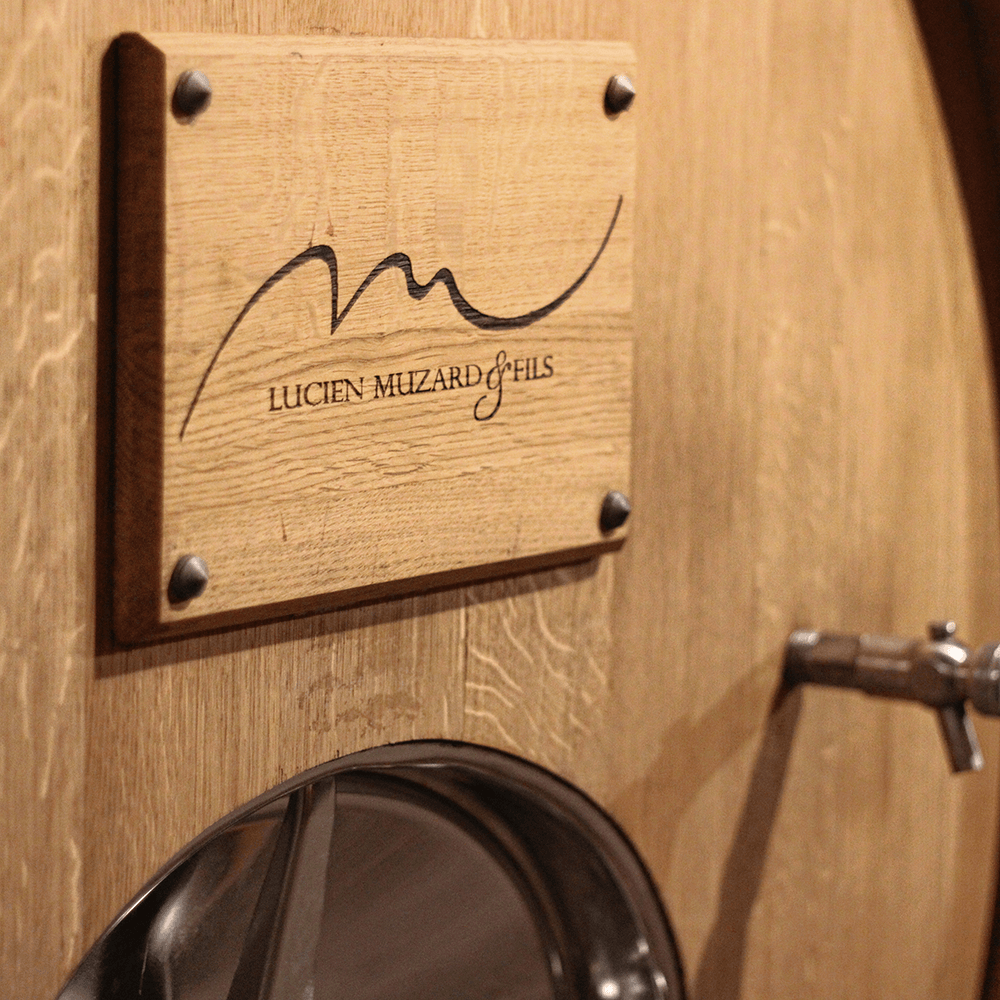
Santenay 1er Cru « Maladière »
PARCEL: Sitting on fissured limestone covered by a thin layer of marl, Maladière is a stony, steep, southeast-facing hillside.
VINEYARDS: The Muzard family cultivates 4.35 hectares on this hillside, with an average vine age of 60 years. The steep slope forces them to plant grass to control erosion. The vines are de-budded, leaf-thinned and harvested by hand.
VINIFICATION: The grapes are never crushed, but mostly de-stemmed (around 30% whole harvest). Alcoholic fermentation is carried out with indigenous yeasts. The wine is lightly pigmented during vatting.
AGEING: After 18 to 20 days, the wines are devatted and blended with free-run wine and press wine for ageing in Burgundian oak barrels, 15 to 20% of which are new. A third of the cuvée is aged in foudres. Aged 12 months.
TASTING NOTES: This wine has beautiful, greedy fruit, with a rich texture, depth and tannins that promise good ageing potential. The generosity of its fruit already offers immediate pleasure and promises delicious moments in the future.
Best in 5 years.
Santenay 1er Cru « Clos Faubard »
PARCEL: This terroir lies at an altitude of 300m. Situated at the top of the hillside, on poor soil, Clos Faubard faces south-east. Limestone is more prevalent in this area.
VINEYARDS: The estate cultivates 1.83 hectares in this climate, with cordon de royat pruning and an average age of 50 years. The soil is ploughed, the vines are disbudded, lifted, thinned out, aerated and harvested by hand.
VINIFICATION: The grapes are never crushed, and are largely destemmed (around 30% whole grapes). Alcoholic fermentation is carried out with indigenous yeasts. The wine is lightly pigmented during vatting.
AGEING: After 18 to 20 days, the wines are devatted and blended with free-run and press wine for aging in Burgundian oak barrels, 15 to 20% of which are new. Aged for 12 months.
TASTING: Clos Faubard is characterized by remarkably pure fruit. Dense and intense, it has a firm, but not hard, structure at its core, offering a texture of great quality. A magnificent wine for laying down, waiting to be discovered.
Apogée 5 years.
Santenay 1er Cru « Gravières »
PARCEL: An extension of Clos de Tavannes, the parcel faces east on marl-limestone soil with numerous limestones.
VINEYARDS: The vineyard was planted in the early 1960s and covers 62 ares of Pinot Noir pruned in cordon de royat. The soil is worked with various ploughs. The vines are disbudded, pruned, thinned out and harvested by hand.
VINIFICATION: The grapes are never crushed, and are largely destemmed (around 30% whole harvest). Alcoholic fermentation is carried out with indigenous yeasts. The wine is lightly pigmented during vatting.
AGEING: After 18 to 20 days, the wines are devatted and blended with free-run and press wine for aging in Burgundian oak barrels, 15 to 20% of which are new. Aged for 12 months.
TASTING: The terroir is fully expressed in this wine, giving it a full-bodied, powerful character, with a lovely texture on the palate.
Peak 5 years.
Santenay 1er Cru « Beauregard »
PARCEL: Beauregard is a Premier Cru located just above Les Gravières. The soil is shallow and composed of various types of limestone.
VINEYARDS: The soil is ploughed, and the vines are disbudded, lifted, thinned out, aerated and hand-harvested.
VINIFICATION: The estate's only cuvée vinified with 100% whole grapes. The grapes are vatted for several days of cold maceration. Alcoholic fermentation is carried out with indigenous yeasts. The wine is lightly pigmented during vatting.
AGEING: After 18 to 20 days, the wines are devatted and blended with free-run wine and press wine for ageing in Burgundy barrels, 15 to 20% of which are new. Aged for 12 months.
TASTING: This wine reveals a deep nose with aromas of strawberries and crushed raspberries, enhanced by a subtle floral and buttery touch. The texture is magnificently smooth, with a full, velvety, silky mid-palate, where the tannins are literally coated by this unctuous fruit.
Apogée 10 years.

Santenay 1er Cru « Clos des Mouches »
PARCEL: Santenay's smallest premier cru, it lies on a south-facing slope, on shallow soil over Jurassic oolitic limestone. In the past, beehives were installed here, and bees were known as "honey flies".
IN THE VINEYARDS: The Muzard family buys grapes from this plot, which they have been following for many years. Planted in the early 1980s, the vines are tended like their own, with cordon de royat pruning. The soil is ploughed, the vines are de-budded, lifted, thinned out, aerated and harvested by hand. Domaine Muzard carries out all mechanical work.
VINIFICATION: The grapes are never crushed, but mostly de-stemmed (around 30% whole grapes). Alcoholic fermentation is carried out with indigenous yeasts. The wine is lightly pigmented during vatting.
AGEING: After 18 to 20 days, the wines are devatted and blended with free-run wine and press wine for ageing in Burgundy barrels, 15% of which are new. Aged for 12 months.
TASTING: Apogée 10 years.
Santenay 1er Cru « Clos de Tavannes »
PARCEL: Le Clos, facing east, backs onto Chassagne and rests on the foothills of the hillside, on a marl-limestone soil of great reputation.
VINEYARDS: The estate cultivates 42 ares of vines planted in 1989. It is pruned to Guyot simple. The soil is worked with various ploughs. The vines are disbudded and leaf-thinned on the sunrise side, by hand, to accustom the bunches to the sun and aerate the vegetation. Harvesting is done by hand.
VINIFICATION: The grapes are never crushed, and are largely destemmed (around 30% whole grapes). Alcoholic fermentation is carried out with indigenous yeasts. The wine is lightly pigmented during vatting.
AGEING: After 18 to 20 days, the wines are devatted and blended with free-run wine and press wine for ageing in Burgundy barrels, 15% of which are new. Aged for 12 months.
TASTING: This wine has great intensity on the palate, with remarkable, subtle, refined sweetness and intriguing complexity. Its length on the palate is highly appreciable. A real charmer.
Apogee 10 years.
Pommard « Les Cras Vieilles Vignes »
PARCEL: The soil is deep, filtering and stony, composed of fine clay over limestone. The plot is located at the bottom of the Pommard hillside, near the Pommard cross, on the Volnay side.
VINEYARDS: The plot covers 31 ares, and the vines, with an average age of over 80 years, are pruned using the guyot simple method. The soil is ploughed, and the vines are disbudded, lifted, thinned out, aerated and hand-harvested.
VINIFICATION: The grapes are never crushed, and are largely destemmed (around 30% whole harvest). Alcoholic fermentation is carried out with indigenous yeasts. The wine is lightly pigmented during vatting.
AGEING: After 18 to 20 days, the wines are devatted and blended with free-run wine and press wine for aging in Burgundy barrels, 15% of which are new. Aged for 12 months.
TASTING: With fruity, spicy aromas and a delicate note of violet, this wine fully reveals the terroir of Pommard. Its silky texture, inherited from the age of the vines, gives it remarkable depth. Concentrated, with fine tannins, this is a wine of great elegance.
Best drunk within 5 years.

-
A word about aging wines
At Domaine Lucien Muzard & Fils, whole grape harvesting is a practice that contributes to enriching the structure and complexity of the wines, offering exceptional ageing potential. This technique allows the wines to gain in sweetness over time, revealing subtle aromas and refined elegance that improve with age.
To make the most of your bottles from Domaine Lucien Muzard, here are a few recommendations:
Villages such as Santenay Champs Claude, Charmes, ... and 1er cru Maladière are wines that are best enjoyed young. Their fresh, fruity character is perfect for immediate tasting, but we advise you to let them age in the cellar for a few years to reveal their full potential.
On the other hand, Meursault and 1er cru Tavannes, Beauregard and Clos Faubard are wines more suited to ageing, and deserve to be patiently stored in your cellar. Their robust structure and intense concentration make them ideal companions for tasting in a few years' time, when their aromas will have reached their full potential.
By following this advice, you can be sure of experiencing exceptional moments in the company of Domaine Lucien Muzard wines. Each bottle represents a unique sensory journey, where time and patience reveal the hidden treasures of each cuvée. So let yourself be seduced by the promise of an unforgettable tasting experience, and treat yourself to the pleasure of savoring wines of rare elegance, at their very best.
DISCOVER THE WINES OF DOMAINE LUCIEN MUZARD & FILS
The entire Wvine team would like to thank Domaine Lucien Muzard & Fils for their confidence!
READ OUR ARTICLE ABOUT THE 2022 MILLENNIUM AT DOMAINE LUCIEN MUZARD & FILs

